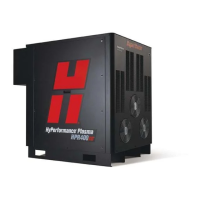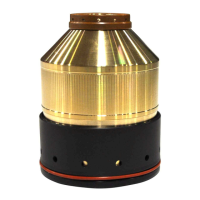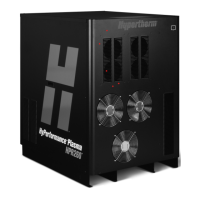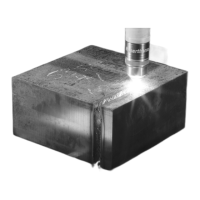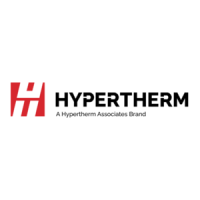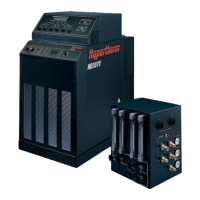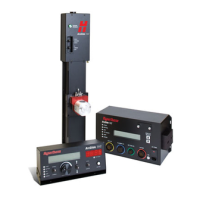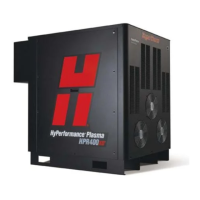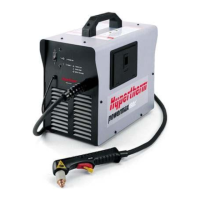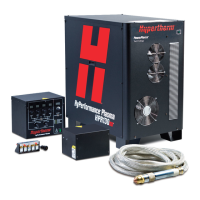10
Moving pierce technique (up to 4-inch stainless steel)
Pierce capacity can be extended by utilizing a technique
known as “moving pierce.” This technique combined with
PowerPierce
®
technology has extended the stainless steel
pierce capacity for the HPR800XD to 4 inches (100 mm)
and for the HPR400XD to 3 inches (75 mm).
The torch lifter must have the capability to use transfer
height, pierce height, and cut height settings along with cut
height and automatic voltage control (AVC) delays. The
cutting table and controller must be able to allow motion
upon transfer. Hypertherm’s EDGE
®
Pro controller (running
Phoenix™ 9.72 or later), Sensor™ THC or ArcGlide
®
lifter,
and ProNest
®
nesting software all support this technique
with the provided parameters.
Basic description
Moving pierce (also known as a running pierce or flying
pierce) is a technique that has been used by plasma
operators for years in order to have their plasma systems
penetrate thick plates without having to resort to other
operations such as drilling.
The method of moving pierce described here utilizes a
synchronization of torch lifter positioning, table motion, and
plasma current ramping to achieve a relatively short pierce
lead-in that directs the molten material to the side and away
from the torch. At the same time, it keeps the torch as far
away from the molten material as possible while also
maintaining an arc voltage that the HPRXD power supply
can sustain.
The basic process consists of combining motion during
piercing to create a trough in the plate that can then be
used as an evacuation channel for the molten material to be
directed out of the deepening pierce “slot.” The molten
material is directed to the side of the torch in the opposite
direction of the table motion, with the majority being
deposited onto the top of the plate surface. Once the arc
penetrates the plate the standard settings for cutting can be
used.
Limitations and equipment and safety hazards
Using this technique results in a “rooster tail” of molten
material and hot gases that can cause personal injury,
damage to equipment, and fires if proper precautions are
not taken. Guards may be required to protect operators and
to prevent the molten material from reaching any flammable
materials (flammable materials should be kept away from
plasma cutting operations). Moving pierce direction should
be planned such that the molten material is not directed at
the lifter, gantry, adjacent torches, controller, or other
sensitive equipment.
Note: The moving pierce parameters in this document were developed
using linear motion only.
Molten material accumulated on the plate can impact
subsequent cutting paths, so you may be required to either
carefully plan cutting paths that avoid the slag pile or to stop
the cutting process (after the arc has penetrated the plate)
to scrape the slag pile from the plate.
Lifter and table motion sequencing
During the moving pierce, both the torch height and the
table motion are simultaneously controlled to optimize the
thick plate piercing capability. The details for a typical pierce
are listed in the following Lifter sequence and Table motio n
sequence sections.
Lifter sequence
Refer to Figure 9 for an illustration of the following
sequence.
1 An initial height sense (IHS) is performed, and the torch is
positioned at the transfer height.
2 The torch is started and transfers to the workpiece; current
ramp-up begins.
3 After transfer, the torch quickly moves to the pierce height,
and the table motion begins at the first speed programmed
using an embedded “F” code. (See Table motion sequence
on page 12.)
4 The torch is maintained at the pierce height until the
moving delay has expired (percentage of the total pierce
delay).
5 When the moving delay has expired, the torch will move to
the pierce end height. This move is timed to arrive at the
end height when the pierce delay has expired.
6 The torch will remain at the pierce end height for the
duration of the cut height delay. When the cut height
delay expires, the torch will move to the cut height and will
remain at this height until the moving pierce (MP) AVC
delay expires.
7 When the MP AVC delay expires, the arc voltage control will
begin.
8 The contour cut of the part is completed.
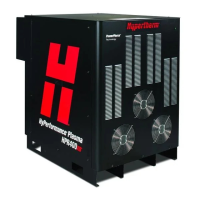
